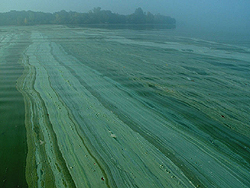 NEWS RELEASE
NEWS RELEASE
ALGOMA PUBLIC HEALTH
*************************
The Ontario Ministry of Environment and Climate Change (MOECC) collected algae samples at Desbarats Lake on August 31, 2015.
Initial laboratory analysis of these samples indicated that there was toxin producing algae in the sample.
Signs will be posted notifying users not to use the water during an algae bloom.
“You can protect your health and that of your family, friends and pets during a blue-green algae bloom” says Gary Leith, Public Health Inspector with Algoma Public Health, by “not drinking the water and avoiding activities that involve direct contact with the bloom such as swimming, water skiing, and showering.”
There are several necessary conditions for an algae bloom to occur.
These conditions include: high levels of nutrients (particularly phosphorous, and also nitrogen), calm water, low or no flow, strong sunlight, relatively clear water (which allows sunlight to penetrate), high air and water temperatures, shallow water (which heats up quickly).
Certain blue-green algae have air sacs that allow them to float to the surface for sunlight and sink to the bottom for nutrients.
This explains why blooms can appear, disappear and reappear quickly.
The blooms can persist for several weeks.
Toxins produced by certain forms of blue-green algae can affect your health in two ways.
Skin contact with the algae through washing or swimming can cause itchy, irritated eyes and skin.
Drinking water contaminated with the toxins can cause nausea, vomiting, abdominal pain and diarrhea.
Liver or nervous system disease can also develop if toxins are consumed over a long period of time.
The occurrence of symptoms and the severity of illness depend on the amount of water consumed.
If illness results after drinking or bathing in the water of lakes with a blue-green algae bloom, see your doctor as soon as possible.
To help and protect the lake, property owners should avoid using lawn and garden fertilizers, increase naturalization of the shoreline, prevent soaps and shampoos from going into the lake during bathing, dishwashing, laundry, and cleaning, and inspect all sewage and waste systems such as septic tanks and tile fields, outhouses, and leaching pits to ensure they are functioning properly and conform to the standards.
Suspect algae blooms can be reported to your local MOECC office.
*************************